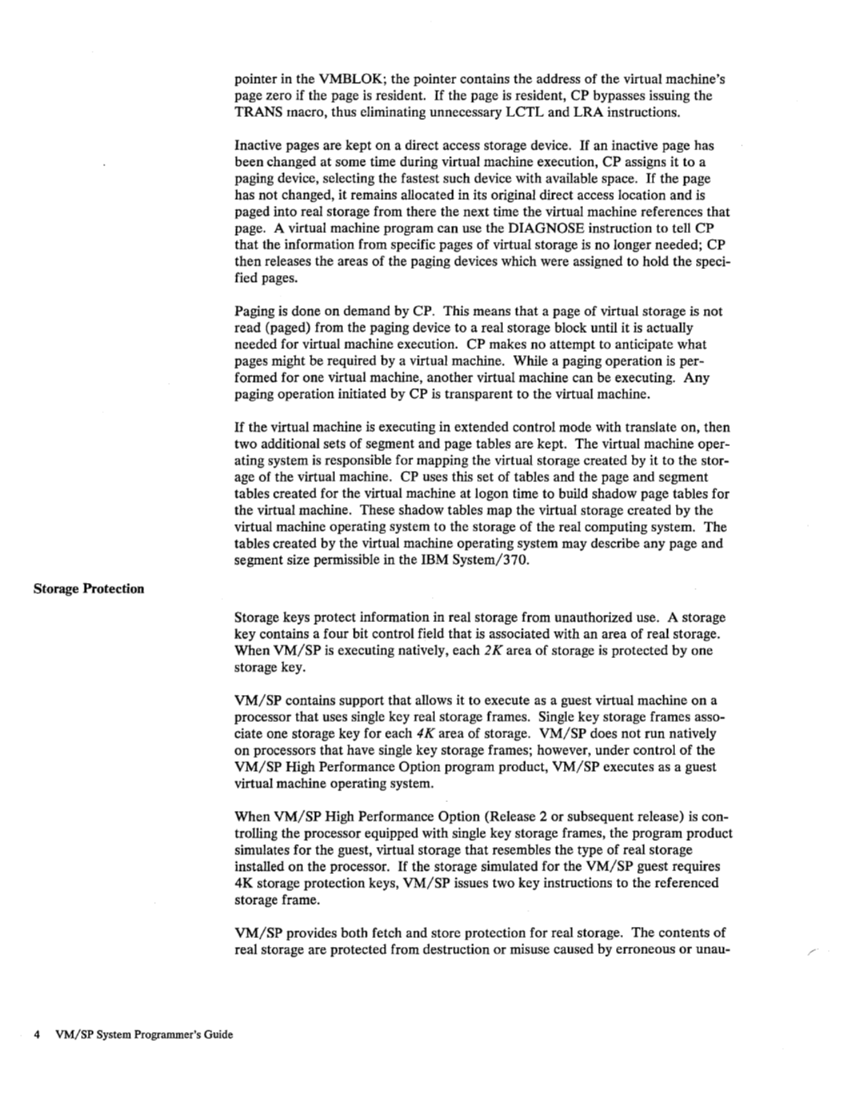Virtual Machine Time Management
The real processor simulates multiple virtual processors. Virtual machines that are
executing in a conversational manner are given access to the real processor more
frequently than those that are not; these conversational machines are assigned the
smaller of two possible time slices.CP determines execution characteristics of a
virtual machine at the end of each time slice on the basis of the recent frequency of
its console requests or terminal interrupts. The virtual machine is queued for sub
sequent processor use according to whether it is a conversational or nonconversa
tional user of system resources.
A virtual machine can gain control of the processor only if it is not waiting for
some activity or resource. The virtual machine itself may enter a virtual wait state
after an input/output operation has begun. The virtual machine cannot gain con
trol of the real processor if it is waiting for a page of storage, if it is waiting for an
input/ output operation to be translated and started, or if it is waiting for aCP command to finish execution.
A virtualmachit:le can be assigned a priority of execution. Priority is a parameter
affecting the execution of a particular virtual machine as compared with other vir
tual machines that have the same general execution characteristics. Priority is a
parameter in the virtual machine'sVM/SP directory entry. The system operator
can reset the value with the privilege class A SETPRIORITY command.
Virtual MachineStorage Management
The normal and maximum storage sizes of a virtual machine are defined as part of
the virtual machine configuration in theVM/SP directory. You may redefine vir
tual storage size to any value that is a multiple of 4K and not greater than the max
imum directory-defined value.VM/SP implements this storage as virtual storage.
The storage may appear as paged or unpaged to the virtual machine, depending
upon whether or not the extended control mode option was specified for that virtu
al machine. This option is required if operating systems that control virtual storage,
such asOS/VS1, VM/370 or VM/SP are run in the virtual machine.
Storage in the virtual machine is logically divided into4096-byte areas called pages.
A complete set of segment and page tables is used to describe the storage of each
virtual machine. These tables are updated byCP and reflect the allocation of vir
tual storage pages to blocks of real storage. These page and segment tables allow
virtual storage addressing in aSystem/370 machine. Storage in the real machine is
logically and physically divided into4096-byte areas called page frames. Only referenced virtual storage pages are kept in real storage, thus optimizing real
storage use. Further, a page can be brought into any available page frame; the
necessary relocation is done during program execution by a combination ofVM/SP and dynamic address translation on the System/370. The active pages from all
logged on virtual machines and from the pageable routines ofCP compete for
available page frames. When the number of page frames available for allocation
falls below a threshold value,CP determines which virtual storage pages currently
allocated to real storage are relatively inactive and initiates suitable page-out oper
ations for them.CP keeps track of where each virtual machine's page zero resides. The normal way CP does this is to issue a TRANS macro, that checks for page residency (LRA)
and demands a page-in if the page is not in real storage.CP checks an in-storage VM/SP 3
The real processor simulates multiple virtual processors. Virtual machines that are
executing in a conversational manner are given access to the real processor more
frequently than those that are not; these conversational machines are assigned the
smaller of two possible time slices.
virtual machine at the end of each time slice on the basis of the recent frequency of
its console requests or terminal interrupts. The virtual machine is queued for sub
sequent processor use according to whether it is a conversational or nonconversa
tional user of system resources.
A virtual machine can gain control of the processor only if it is not waiting for
some activity or resource. The virtual machine itself may enter a virtual wait state
after an input/output operation has begun. The virtual machine cannot gain con
trol of the real processor if it is waiting for a page of storage, if it is waiting for an
input/ output operation to be translated and started, or if it is waiting for a
A virtual
affecting the execution of a particular virtual machine as compared with other vir
tual machines that have the same general execution characteristics. Priority is a
parameter in the virtual machine's
can reset the value with the privilege class A SET
Virtual Machine
The normal and maximum storage sizes of a virtual machine are defined as part of
the virtual machine configuration in the
tual storage size to any value that is a multiple of 4K and not greater than the max
imum directory-defined value.
The storage may appear as paged or unpaged to the virtual machine, depending
upon whether or not the extended control mode option was specified for that virtu
al machine. This option is required if operating systems that control virtual storage,
such as
Storage in the virtual machine is logically divided into
A complete set of segment and page tables is used to describe the storage of each
virtual machine. These tables are updated by
tual storage pages to blocks of real storage. These page and segment tables allow
virtual storage addressing in a
logically and physically divided into
storage use. Further, a page can be brought into any available page frame; the
necessary relocation is done during program execution by a combination of
logged on virtual machines and from the pageable routines of
available page frames. When the number of page frames available for allocation
falls below a threshold value,
allocated to real storage are relatively inactive and initiates suitable page-out oper
ations for them.
and demands a page-in if the page is not in real storage.



































































































































































































































































































































































































































































































































































































































